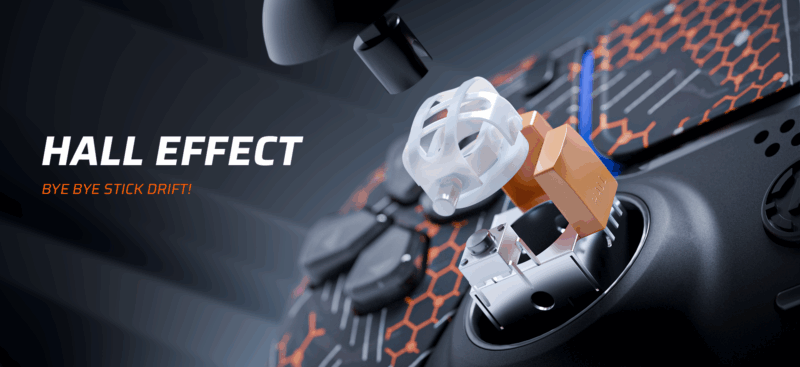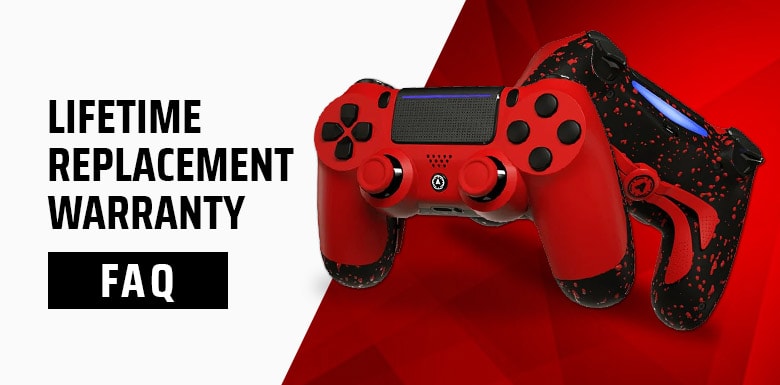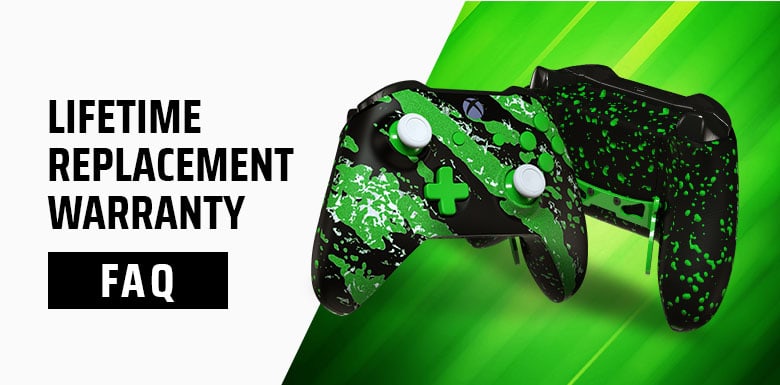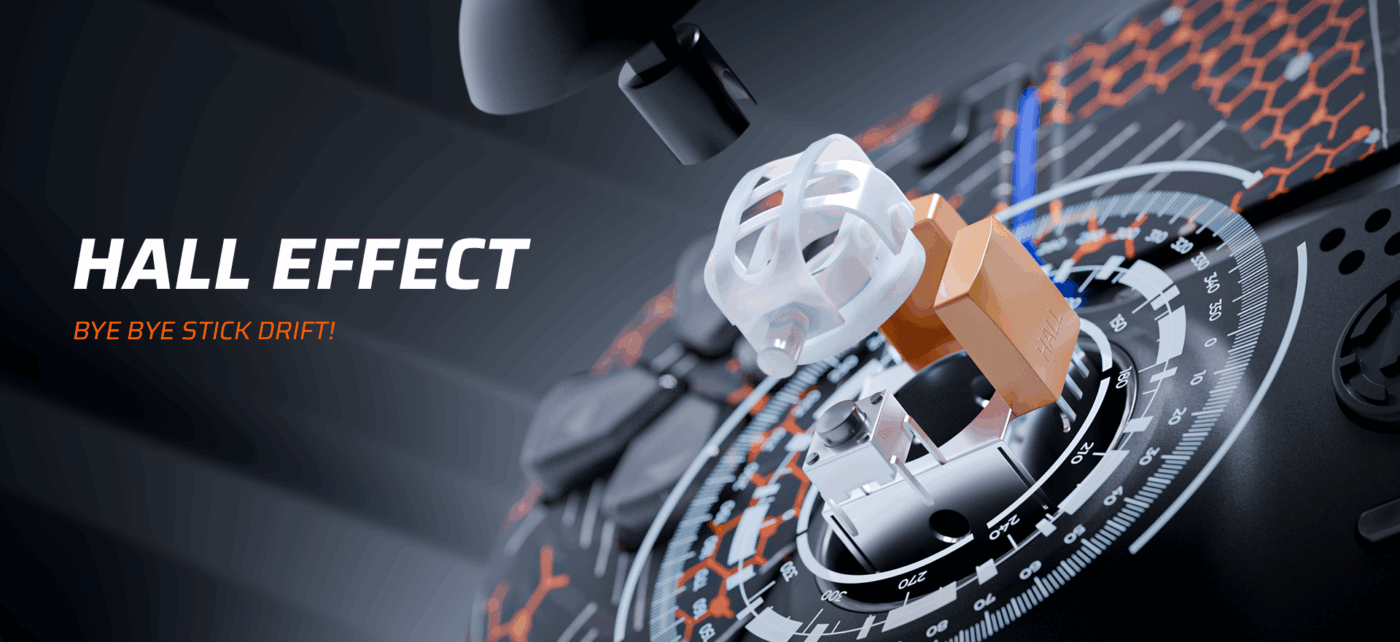Hall Effect Sensor Technology to Boost the Performance of Your Controller
Hall Effect Sensors convert magnetic field changes into precise electrical signals, replacing potentiometer parts in a controller.
Consequently, contactless input extends device lifespan while boosting accuracy for game controllers and industrial panels. Furthermore, by eliminating stick drift, Hall Effect Sensors deliver lasting precision even in harsh conditions.

The Hall Effect Principle
Originally discovered by Edwin Hall in 1879, the Hall Effect arises when a magnetic field perpendicular to an electric current exerts a Lorentz force on moving charge carriers.
As a result, electrons and positive ions shift to one side of a flat conductor, creating a transverse voltage called the Hall voltage. Moreover, the polarity of this voltage indicates the vector direction of the applied magnetic field.
Thus, a simple probe can measure changes in the magnetic field without any physical contact. Consequently, devices used to measure magnetic field variations do so reliably via this contactless method.
Anatomy of a Hall Effect Sensor
Fundamentally, an element—typically an n-type semiconductor wafer—connects to input contacts for an electric field and paired electrodes to read the transverse voltage.
When magnetic field strength shifts, negative charge carriers deflect within the semiconductor, altering the measurable voltage at the electrodes. Importantly, because there’s no sliding contact, mechanical switch wear is avoided.
Additionally, modern Hall Effect devices integrate on-chip amplification and temperature compensation, plus a digital output, so the converter module fits easily onto a PCB. Accordingly, a Hall Effect switch inside a controller replaces a mechanical switch assembly, providing drift-free operation.
Why Hall Effect Sensors Dominate in Controllers
Firstly, the Hall Effect can be used in the best game controllers to deliver precise inputs without the drawbacks of mechanical wear and tear, as sensors detect changes in the magnetic field rather than relying on physical contacts.
Moreover, this contactless conduction mechanism ensures that there is no friction between moving components, thereby minimising maintenance and lifespan.
Consequently, the measured electric potential arises solely from the influence of the external magnet’s field, eliminating the variable resistance issues common to potentiometer-based sticks. As charge carriers are deflected by the perpendicular magnetic field, a well-defined potential difference—known as the Hall voltage—appears across the sensor’s transverse electrodes.
Furthermore, the polarity of the hall voltage directly indicates the direction of stick movement—positive or negative—so every tiny push or pull translates into an accurate analogue signal.
In addition, because the sensor operates in a current-carrying semiconductor, disturbances from dust, dirt, or moisture cannot interrupt the magnetic measurement, unlike in traditional potentiometers.
Meanwhile, the properties of the charge carriers—specifically their drift velocity under an applied magnetic field—remain stable over a wide temperature range, which means that readings stay consistent even during marathon gaming sessions or under extreme environmental conditions.
Consequently, when a magnet on a joystick shifts closer or farther from the sensor, carriers are deflected to generate a voltage that precisely maps stick position, eliminating drift and repeater errors.
Key Advantages of Hall Effect Controllers:
-
Drift-Free Precision: By measuring a potential difference generated by the Lorentz force on charge carriers, hall effect joysticks deliver unwavering accuracy throughout their lifespan, without requiring recalibration.
-
Extended Durability: Because there’s no physical contact, there’s no mechanical abrasion; hence, Hall effect sticks often last two to three times longer than potentiometer-based counterparts.
-
Rapid Response: The sensor’s reading of the polarity of the hall voltage changes virtually instantaneously as the magnet moves, providing faster input recognition and lower input lag for competitive play.
-
Environmental Resistance: Sealed hall effect modules shrug off dust, moisture, and temperature fluctuations, since the conduction path relies on a current through a semiconductor, not a sliding wiper.
-
Low Dead Zone: Because the sensor picks up even minute magnetic field shifts, the joystick’s dead zone is negligible, yielding smoother, more natural control over character movements or camera angles.
-
Consistent Calibration: Once installed, Hall effect sticks maintain their zero-point indefinitely, as there’s no mechanical drift; this is possible because the Hall voltage’s polarity and magnitude remain stable thanks to the properties of the charge carriers.
-
Customisable Feel: Many personalized Xbox and PS5 controllers allow firmware adjustment of the magnetic threshold, letting users alter sensitivity without hardware changes, since the sensor measures the potential difference created when the magnet’s field crosses that threshold.
-
Simplified Manufacturing: With fewer moving parts, integrating a hall sensor into the controller’s PCB reduces assembly complexity, as the design focuses on aligning a magnet and the current-carrying semiconductor, rather than calibrating mechanical potentiometers.
-
Broader Compatibility: Because hall effect sensors respond to magnetic field changes, they work reliably with different magnet sizes and shapes, which benefits custom controllers or modular designs where magnetic geometry might vary.
-
Reduced Maintenance: Without sliding contacts to wear out, there’s no need for periodic cleaning or lubrication; the sensor simply measures the electric potential created when carriers are deflected under a magnetic field.
-
Resilience to Shocks: During sudden impacts or device drops, hall effect sensors continue to measure accurately, as the solid-state semiconductor remains intact, unlike mechanical parts which might become misaligned.
-
Scalable Integration: Developers can add extra axes of detection or integrate triggers with hall effect switches in the same PCB footprint, since the technology leverages conduction in a conductor and doesn’t require bulky potentiometer housing.
Hall Effect Joysticks – Drift Elimination
In hall effect joysticks, a tiny magnet shifts relative to a Hall element. Hence, any change in magnetic field strength produces a proportional Hall voltage, so stick drift is effectively eliminated.
Gamers enjoy precise, fluid control during continuous gameplay. Moreover, since the magnet never touches the hall element, mechanical drift is impossible and wear is nonexistent in these modules.
Hall Effect Keyboards – Enhanced Reliability
Now, high-end keyboard designs employ hall effect switches in place of traditional mechanical switch contacts. Each key contains an embedded magnet that moves near a sensor, altering the perpendicular magnetic field as it’s pressed.
As a result, the sensor reports voltage changes instantly and without contact bounce, providing rapid response. Additionally, this approach eliminates switch fatigue and extends key lifespan almost indefinitely. Consequently, users gain customisable actuation points and ultra-reliable performance.
Materials and Performance
Typically, hall elements consist of a thin conductive strip of gallium arsenide or indium antimonide—both n-type semiconductors offering high carrier mobility and stable drift velocity.
Thus, even small magnetic field changes yield a measurable voltage. Furthermore, integrated temperature compensation inside such a device keeps sensitivity high over wide temperature ranges, with minimal offset errors. In short, this design leverages the properties of charge carriers in condensed matter to maintain accuracy in harsh environments.
Broader Hall Effect Devices Uses
Beyond gaming peripherals, hall effect sensors power proximity switches, current sensing modules, and brushless motor control systems.
For instance, in automotive assemblies, a hall effect sensor serves as a wheel-speed sensor or throttle-position sensor, detecting rotation and flow without mechanical contact. In industrial settings, fluid-level detection uses a float magnet and sensor to track liquid changes.
Because there is no magnetoresistance degradation from repeated contact, hall effect modules offer reliable readings in dusty or moist conditions. Therefore, designers use these sensors wherever a contactless, drift-free converter is essential.
Conclusion
In summary, hall effect sensors eliminate stick drift and wear by employing a contactless method to monitor magnetic field changes.
By replacing traditional potentiometers in game controllers, joysticks, and keyboards, these sensors enhance precision, durability, and resistance to environmental factors.
Consequently, the technology provides a longer lifespan and unrivalled accuracy in modern controllers.


















Latest news
Mastering the Custom Controller Setup for FPS Games
Master Optimising AimController for Competitive FPS Games – FPS Controller Setup Competitive Edge Ranked FPS [...]
Nov
Custom Controller Build for Racing and Fighting Games: PS5, PC & Xbox
Customising Controller for Racing & Fighting Games: Wireless Custom Controller Build, Design, and Style Racing [...]
Nov
Is a Customizable Game Controller Worth It?
Customisable Game Controllers in 2025: The Future of PC Gaming A controller is one of [...]
Oct
Best Controller Settings fo Battlefield 6: Best AimController Setup
The Best Controller Settings for Battlefield 6 BF 6 is set to redefine the first-person [...]
Oct
Key Gaming Trends of 2026
Key Gaming Trends of 2026 The gaming industry in 2026 is entering an age of [...]
Aug
How To Use a PS5 Controller on PC
How to Use the PS5 Controller on PC: A Complete Guide to Connect and Use [...]
Aug
Mortal Kombat Series – Legendary Fighting Game
Mortal Kombat Series – The Legendary Changing Fighting Game Mortal Kombat isn’t just another fighting [...]
Jul
The Benefits of Hall Effect Sensors in Controllers
Hall Effect Sensor Technology to Boost the Performance of Your Controller Hall Effect Sensors convert [...]
Jul